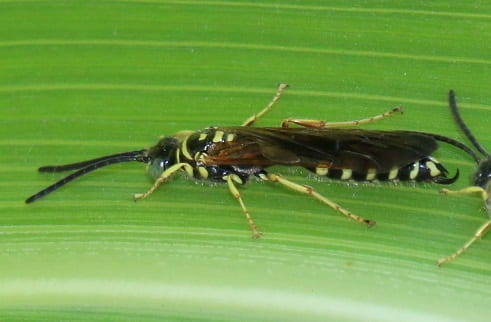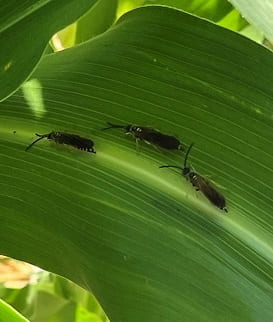–by Anthony Zukoff –Southwest Research and Extension Center – Garden City, KS
A wasp commonly found during the summer in Kansas has recently caused concern among home owners and producers. In one instance, several wasps were mistaken for wheat stem sawfly, a significant pest of wheat that has not yet established in Kansas. Sometimes referred to as flower wasps, the Five-banded Tiphiid Wasp (Myzinum quinquecinctum), is a harmless solitary wasp found throughout most of the country.

Male Flower Wasp
In Kansas, it is found statewide and is most common mid to late summer. These ¾ to 1 inch long, narrow bodied wasps have dark bodies, long antennae and smoky wings. Yellow markings are visible on their thorax and yellow bands are present on each abdominal segment. Subtle differences set apart males and females. Male wasps have yellow legs, while females have stockier orange-red legs and wider yellow bands on their abdominal segments. Both male and females visit flowers to feed on nectar. Females are parasitoids of various scarab beetle larvae, including common turfgrass pests such as white grubs, and have been promoted as biocontrol tools in farm and turf settings. Female wasps seek out beetle larvae in the ground, digging for them with their stocky legs. She then deposits an egg on the body of the grub and injects a neurotoxin to paralyze it. As the wasp larva develops it will consume the beetle larva. The wasp then overwinters as a pupa below the ground and emerges as an adult the following summer. Since the populations of both the wasp and its host fluctuate yearly, the level of parasitism changes from season to season. This results in some years where many wasps successfully overwinter and emerge in large numbers.

Male Wasps on Corn
The female wasps are not commonly encountered. In fact, it is the male of this species that most often causes alarm. This is due to the fact that the males tend to congregate together in large numbers on vegetation and occasionally even on home siding. These groups are typically attracted to an area because there are nectar sources, shade or tall grass to shelter on over the evening. When approached or disturbed, the group of male wasps take flight and fly circles around the location, giving the appearance of an angry swarm of wasps. The males have no stinger and are harmless, however, the hooked appendage at the end of their abdomen is often mistaken for a stinger, adding to the alarm. Despite their behavior and large numbers, these wasps are no threat to people, pets or landscaping. As summer progresses, these groups of male flower wasps will slowly die off and eventually disappear.